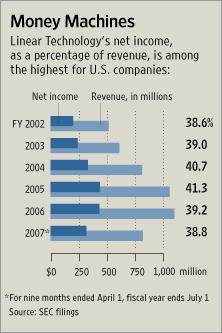 Source of graph: online version of the WSJ article cited below.
Source of graph: online version of the WSJ article cited below.
The key to business success is usually thought to be to beat the competition. An alternative sketched by Clayton Christensen, and in the book Blue Ocean Strategy, is to do something that the competition isn’t doing. As a once-famous, old-time baseball player once said: "Hit ’em where they ain’t."
MILPITAS, Calif. — Erik Soule had been waiting 15 months for this moment. The semiconductor engineer was about to launch a new chip, and he needed his pricing approved. In a conference room at Linear Technology Corp., Mr. Soule anxiously explained why his amplifier chip is so advanced that it should sell for $1.68, a third more than its rivals.
His bosses’ reaction: Charge even more. The chip is 30 times better than the competition, they asserted, and high-end customers will crave it on any terms. Why not boost the $1.68 list price by 10 cents? Mr. Soule was nervous. "I can live with that," he guardedly replied, "but what does that accomplish?"
"It’s a dime!" declared Linear’s chairman and founder, Robert Swanson. "And those dimes add up."
For many U.S. companies, such exuberant pricing power vanished long ago. They now struggle to deliver more at lower prices, amid intense global competition. But Linear has built one of the world’s strongest profit fortresses by staying strictly at the fringes, where competition is low and margins are still high.
Away from the semiconductor industry’s frenzied center stage, this midsize company makes 7,500 arcane, unglamorous products that solve real-world problems for a long list of customers. Instead of the better-known digital chips that power the brains of the world’s computers and bring in 85% of the industry’s revenue, Linear makes so-called analog chips that are too cheap for customers to haggle over, but perform chores too important to ignore.
Pick apart a medical ultrasound machine, a hybrid car battery or thousands of other costly devices, and somewhere inside is a Linear chip that helps monitor power consumption or guard against voltage surges. It’s a backwater of high tech well-suited to Linear’s engineer-driven culture, where quirky developers shop for old part testers at flea markets to keep costs down. Many of Linear’s chips cost less than 50 cents to build and sell for three to four times as much, but customers seldom complain about the markup.
Linear made a 39% profit on its $1.1 billion in sales in calendar 2006 — more than five times the average for U.S. industrial companies. Linear easily outpaced even the tech industry’s best-known profit powerhouses, Microsoft Corp. and Google Inc., which earned profits of 26% and 24% of sales for the same period.
For the full story, see:
 CEO of Linear Technology Corp. Source of image: online version of the WSJ article cited above.
CEO of Linear Technology Corp. Source of image: online version of the WSJ article cited above.
